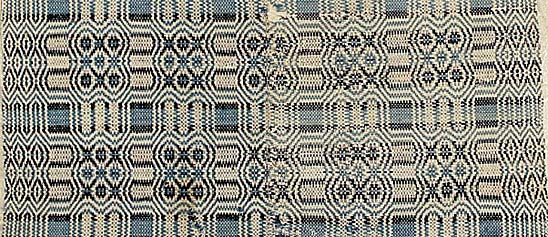"There was exhibited at the late Mechanical Fair held at Chicago, Ill., by Mr. C. Taylor, of that place, a quilt composed of 9,800 pieces of silk, each of which was about an inch square and all sewed with exceeding beauty and neatness.
- Description
-
"There was exhibited at the late Mechanical Fair held at Chicago, Ill., by Mr. C. Taylor, of that place, a quilt composed of 9,800 pieces of silk, each of which was about an inch square and all sewed with exceeding beauty and neatness. Its chief charm, however, was the great skill evinced in the ingenious blending of colors, so as to produce a proper effect in the representation of various figures which ornamented it in every part. A brilliant sun shown in the centre, the moon and stars beamed out from one corner, while in another appeared a storm in the heavens, with lowering clouds and flashes of lightning.
-
Around the border were various designs illustrative of the season and the rapid growth of the western country. At one place appeared a barren heath, with Indians and hunters roaming over it; next, a trading post, as the first entrance of civilization; next, a military station, with the glorious banner of our country streaming from the flagstaff; then a city, and steamboats and vessels gliding in and out of port." "Great Quilt," Scientific American, Volume 5, Number 12, December 8, 1849.
-
The quilt described in the 1849 Scientific American, may well have been Mary Willcox Taylor's silk quilt made between 1830 and 1850 and brought to the Museum in 1953. Although the pieced and appliquéd quilt was made in Detroit, Michigan it was said that Mary at one time had lived at Fort Dearborn. In one corner of the quilt is depicted a military fort complete with a prominent U.S. flag on a pole. Fort Dearborn was completed in 1804, burned by Indians in 1812 and rebuilt in 1816. It was demolished in 1856 to accommodate the rapidly expanding city of Chicago. Today, a plaque located in the Chicago Loop recognizes the earlier Fort Dearborn.
-
Mary used many shades of silk, even a few embellished with water-colors to depict the skies from dawn to dusk, sunny to stormy. Vignettes on the outer edges of the quilt are detailed and precise using many different fabrics and techniques. They portray scenes of the growth and changes in Chicago during the first half of the nineteenth century. All the diamond shaped pieces are quilted in an outline pattern. Now, unfortunately too fragile to exhibit, this example of a nineteenth-century pictorial quilt displays the skills and artistic ability of Mary Willcox Taylor.
- Location
-
Currently not on view
- Date made
-
1830-1850
- quilter
-
Taylor, Mary Willcox
- ID Number
-
TE.T11053
- accession number
-
197748
- catalog number
-
T11053
